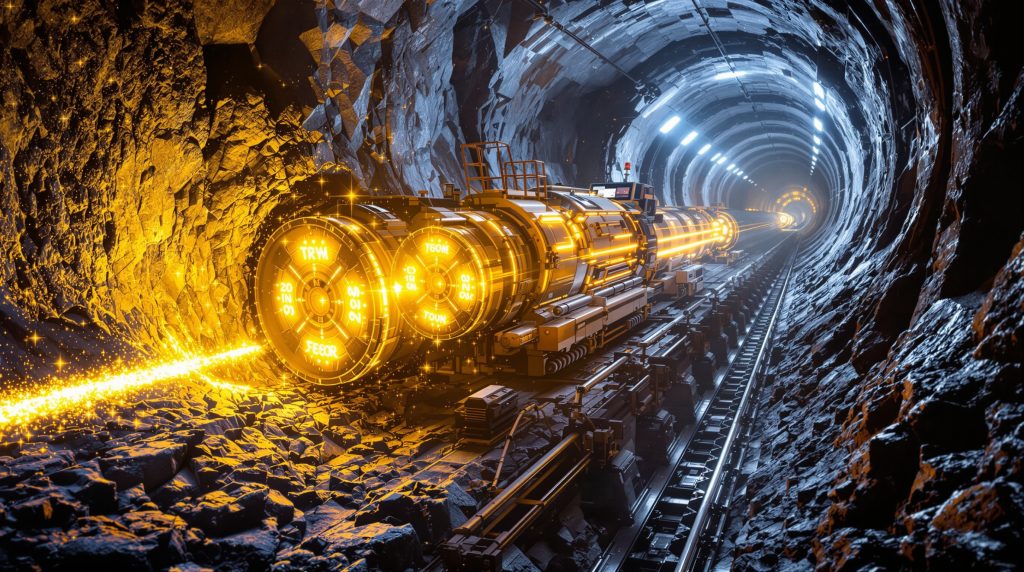Tunnel Boring in Narrow Reef Mining: Revolutionizing Underground Extraction
Tunnel boring machines (TBMs) are transforming the landscape of narrow reef mining operations worldwide, offering a revolutionary approach to mineral extraction in confined underground spaces. These specialized mechanical excavators are increasingly replacing traditional drill-and-blast methods, providing mining companies with significant advantages in safety, productivity, and resource recovery when extracting thin, tabular ore deposits. With ongoing mining innovation trends, the use of tunnel boring in narrow reef mining is gaining considerable momentum in the industry.
Understanding Narrow Reef Mining Challenges
Narrow reef mining involves extracting minerals from thin, tabular ore bodies typically less than 1.2 meters thick. These deposits present unique challenges for mining operations:
- Limited working space for equipment and personnel
- High dilution rates when traditional blasting methods are used
- Difficulty maintaining ore grade due to waste rock contamination
- Labor-intensive extraction methods leading to elevated operating costs
- Safety risks associated with conventional blasting techniques
- Complex ventilation requirements in confined spaces
Why Are Mining Companies Adopting Tunnel Boring Technology?
The shift toward tunnel boring technology in narrow reef mining is driven by several compelling advantages over conventional methods. Mining companies worldwide are recognizing these benefits as they seek to improve operational efficiency, safety, and resource recovery through modern mine planning.
Precision Excavation and Grade Control
TBMs designed for narrow reef applications feature specialized cutting heads that enable highly selective ore extraction. This precision offers significant improvements over traditional methods:
- Ability to follow thin ore seams with centimeter-level accuracy
- Maintenance of consistent excavation profiles throughout the operation
- Reduction in dilution rates by up to 30% compared to drill-and-blast methods
- Significant increase in recovered ore grade through precise cutting
- Ability to maintain mining width as narrow as 0.6 meters in appropriate geological conditions
Enhanced Safety Performance
Safety improvements represent one of the most compelling advantages of tunnel boring technology in narrow reef mining:
| Safety Factor | Traditional Methods | Tunnel Boring Approach |
|---|---|---|
| Rockfall exposure | High risk during manual drilling and support installation | Reduced by 85% through remote operation and immediate ground support |
| Blast-related injuries | Common hazard from flyrock and gases | Eliminated (no explosives required) |
| Dust exposure | Significant during blasting and mucking | Reduced by 70% with integrated dust suppression |
| Noise levels | Excessive with pneumatic equipment | Reduced by 50% with electric drives |
| Ground stability | Variable due to blast damage | Improved due to minimal disturbance of surrounding rock |
Operational Efficiency Gains
Modern narrow reef boring machines deliver significant operational advantages that translate directly to improved productivity and cost efficiency:
- Continuous operation: Unlike cyclic drill-and-blast methods that require evacuation during blasting, TBMs can operate continuously, increasing advance rates by 40-60%
- Integrated ground support: Many systems install rock bolts and mesh simultaneously with excavation, eliminating separate support cycles
- Reduced ventilation requirements: With no blast gases to clear, ventilation infrastructure can be significantly smaller
- Lower labor requirements: Automation reduces workforce needs by up to 50% compared to conventional mining
- Improved development rates: Advanced TBMs can achieve 15-20 meters of advance per day versus 3-5 meters with conventional methods
- Reduced energy consumption: Electric-powered TBMs typically use 25-35% less energy per ton of ore recovered
What Types of Tunnel Boring Systems Are Used in Narrow Reef Mining?
The tunnel boring systems employed in narrow reef mining vary depending on the specific requirements of the deposit, ground conditions, and operational objectives. Several specialized machine types have been developed to address the unique challenges of narrow reef environments.
Full-Face Tunnel Boring Machines
Full-face TBMs excavate the entire tunnel cross-section simultaneously using a rotating cutterhead equipped with disc cutters or pick cutters. These machines are primarily used for main development tunnels and access ways:
- Typically range from 3.5 to 6 meters in diameter for main development tunnels
- Create smooth tunnel walls that require minimal additional support
- Achieve high advance rates in consistent ground conditions
- Require significant capital investment and setup time
- Limited flexibility for changing tunnel dimensions
Narrow Reef Boring Machines
Specialized narrow reef boring machines are designed specifically for extracting thin, tabular ore bodies with minimal dilution. According to recent developments in narrow reef boring technology, these systems:
- Feature low-profile designs to operate in seams as thin as 0.6 meters
- Utilize horizontal cutting heads that follow the reef plane with precision
- Include integrated navigation systems to track and maintain position within the ore zone
- Often incorporate continuous haulage systems to remove cuttings efficiently
- Can achieve selectivity impossible with conventional mining methods
Mobile Tunnel Miners
Mobile tunnel miners represent a hybrid approach, combining elements of roadheaders and TBMs to provide greater flexibility in varying ground conditions:
- More adaptable than full-face TBMs for changing tunnel dimensions
- Can negotiate tighter curves than conventional TBMs (minimum radius as low as 12 meters)
- Suitable for development tunnels and access ways in variable geology
- Lower capital cost but typically slower advance rates than full-face TBMs
- Greater versatility for mines with changing geological conditions
How Are Tunnel Boring Machines Implemented in Narrow Reef Operations?
The successful implementation of tunnel boring technology in narrow reef mining requires careful planning, specialized infrastructure, and advanced technical capabilities. The process involves several critical steps to ensure optimal performance.
Planning and Geological Assessment
Successful implementation begins with comprehensive planning and geological evaluation:
- Detailed geological mapping and characterization of the reef structure
- Extensive rock mechanics testing to determine optimal cutting parameters
- 3D geological modelling to plan boring trajectories with precision
- Simulation of machine performance in expected ground conditions
- Development of contingency plans for geological anomalies
Infrastructure Requirements
TBM operations require specialized infrastructure that must be carefully designed and implemented:
- Robust electrical power supply (typically 1-3 MW depending on machine size)
- Reliable water systems for cooling and dust suppression
- Backup systems for critical components to minimize downtime
- Continuous conveyor or rail systems for efficient muck removal
- Specialized maintenance areas for cutterhead servicing and component replacement
- Advanced communication networks for real-time monitoring and control
Navigation and Guidance Systems
Modern narrow reef boring systems employ sophisticated guidance technology to maintain accurate positioning within the ore body:
- Inertial navigation systems track position relative to the reef with high precision
- Continuous probe drilling ahead of the machine to verify ore position
- Real-time grade control through analysis of cuttings
- Laser alignment systems to maintain accurate trajectories
- Integration with mine planning software for deviation correction
- Geophysical sensing technologies to identify geological boundaries
What Are the Economic Benefits of Tunnel Boring in Narrow Reef Mining?
The economic case for tunnel boring in narrow reef mining is compelling, particularly when considering the full lifecycle costs and benefits of these advanced systems.
Improved Resource Recovery
The precision of tunnel boring technology translates directly to economic benefits through improved resource recovery:
- Recovery rates as high as 95% compared to 60-70% with conventional methods
- Reduced dilution means less waste processing and higher mill feed grades
- Extension of mine life through access to previously uneconomic areas
- Ability to mine narrower reefs that would be unprofitable with traditional methods
- Reduced waste handling and processing costs throughout the value chain
Capital and Operating Cost Considerations
While tunnel boring machines require significant upfront investment, the economic case often becomes compelling when considering total cost of ownership:
- 30-40% reduction in overall development costs per meter advanced
- 25-35% lower operating costs once systems are established
- Reduced labor costs through automation and higher productivity
- Lower ventilation and support costs throughout mine life
- Decreased energy consumption per tonne of ore produced
- Reduced processing costs due to lower dilution and higher feed grades
Case Study: Economic Impact
A platinum mine in South Africa implementing narrow reef boring technology reported significant economic benefits:
- Initial capital cost: $15-20 million per boring system
- 45% reduction in cost per tonne of ore recovered after implementation
- 30% improvement in recovered grade due to reduced dilution
- Payback period of 18-24 months at current metal prices
- Extension of mine life by approximately 8 years through access to previously uneconomic areas
- Overall net present value improvement of 35% compared to conventional mining
What Environmental Benefits Does Tunnel Boring Offer?
Beyond the operational and economic advantages, tunnel boring technology offers significant environmental benefits that align with mining companies' increasing focus on sustainability and innovative mine reclamation.
Reduced Surface Disruption
Tunnel boring technology contributes to more environmentally sustainable mining through reduced surface impact:
- Smaller surface footprint due to reduced ventilation requirements
- Lower water consumption compared to conventional mining methods
- Decreased waste rock production, reducing tailings storage requirements
- Reduced dust and noise emissions affecting surrounding communities
- Minimal surface subsidence due to controlled excavation and support
Energy Efficiency and Carbon Reduction
Modern TBMs support mining companies' decarbonization efforts through improved energy efficiency:
- Electric drives replace diesel equipment, reducing direct emissions
- More efficient ore extraction reduces energy per tonne produced
- Continuous operation eliminates energy-intensive restart cycles
- Potential for regenerative braking systems to recover energy
- Reduced processing energy due to less waste material handling
- Smaller ventilation systems require less energy to operate
What Challenges Must Be Overcome When Implementing Tunnel Boring Technology?
Despite the numerous advantages, implementing tunnel boring technology in narrow reef mining presents several challenges that must be addressed for successful adoption.
Technical Limitations
Tunnel boring systems face several technical challenges in narrow reef applications that require careful consideration:
- Limited flexibility to adapt to significant geological changes
- Difficulty negotiating sharp turns in the ore body
- Vulnerability to unexpected geological features (faults, dykes, water-bearing zones)
- Maintenance complexity in confined underground spaces
- High capital cost creating barriers to adoption for smaller operations
- Longer lead times for equipment procurement and setup
Operational Adaptations
Mining companies implementing tunnel boring technology must adapt their operations to accommodate this fundamentally different approach:
- Workforce retraining from conventional mining skills to TBM operation
- Development of specialized maintenance protocols and capabilities
- Redesign of mine planning approaches to optimize for continuous boring
- Integration with existing mine infrastructure and haulage systems
- Creation of new operational procedures and safety protocols
- Cultural shift from cyclic to continuous mining mentality
What Does the Future Hold for Tunnel Boring in Narrow Reef Mining?
The future of tunnel boring in narrow reef mining looks promising, with ongoing technological developments and increasing industry adoption driving continued innovation and improvement.
Technological Advancements
The next generation of narrow reef boring technology is focusing on several key areas of advancement with AI in mining technology playing a crucial role:
- Increased automation and remote operation capabilities
- Improved cutting tools for harder rock types and abrasive materials
- More compact designs for ultra-narrow reefs (below 0.5 meters)
- Integration of real-time ore sorting and analysis
- Hybrid systems combining mechanical cutting with water jet assistance
- Advanced materials for longer component life in abrasive conditions
- Artificial intelligence for predictive maintenance and optimal cutting parameters
Industry Adoption Trends
The mining industry is increasingly embracing tunnel boring technology as part of a broader shift toward more efficient, safer, and more sustainable mining practices:
- Major mining houses establishing dedicated mechanical mining divisions
- Collaborative development between equipment manufacturers and mining companies
- Standardization of boring systems to reduce costs and improve reliability
- Integration with mine digitalization initiatives for predictive maintenance and performance optimization
- Application to an expanding range of mineral deposits and geological conditions
- Growing acceptance as the method of choice for new narrow reef developments
Transforming Narrow Reef Mining Through Mechanical Excavation
Tunnel boring technology represents a paradigm shift in narrow reef mining, offering a safer, more efficient, and environmentally sustainable alternative to conventional methods. While challenges remain in implementation and adaptation, the compelling benefits in safety, productivity, and resource recovery are driving increasing adoption across the industry.
As mining companies face pressure to improve safety performance, reduce environmental impact, and access increasingly complex ore bodies, tunnel boring machines will likely play an expanding role in the future of narrow reef mining operations worldwide. The technology continues to evolve, with advances in automation, cutting mechanisms, and guidance systems further enhancing the value proposition for mining companies.
The transformation of narrow reef mining through tunnel boring technology exemplifies how innovation can address the fundamental challenges of mineral extraction while improving economic outcomes, safety performance, and environmental sustainability. For mining companies seeking to maintain competitiveness in challenging geological conditions, tunnel boring technology offers a compelling solution that aligns with broader industry trends toward mechanization, digitalization, and sustainable resource development.
FAQ: Tunnel Boring in Narrow Reef Mining
What is the typical advance rate for a narrow reef boring machine?
Modern narrow reef boring systems can achieve 15-20 meters of advance per day in favorable conditions, compared to 3-5 meters with conventional drill-and-blast methods.
How does tunnel boring affect ventilation requirements?
Tunnel boring eliminates the need to clear blast gases, reducing ventilation requirements by 30-40% compared to conventional mining methods.
Can tunnel boring machines operate in all rock types found in narrow reef deposits?
While TBMs can be designed for various rock hardnesses, extremely variable or highly fractured ground conditions can challenge their effectiveness. Hybrid systems combining mechanical cutting with other methods are being developed for these situations.
What is the typical lifespan of a tunnel boring machine in mining applications?
With proper maintenance, narrow reef boring machines typically operate for 8-10 years before requiring major refurbishment, though cutting tools require regular replacement based on rock conditions.
How does the cost of tunnel boring compare to conventional mining methods?
While initial capital costs are 3-4 times higher than conventional equipment, operating costs are typically 25-35% lower, resulting in favorable total cost of ownership for mines with sufficient reserves to justify the investment.
Ready to Gain an Edge in Mining Investment Opportunities?
Discover how significant mineral discoveries can lead to substantial market returns by exploring Discovery Alert's dedicated discoveries page, where their proprietary Discovery IQ model transforms complex mining data into actionable investment insights for ASX-listed companies.




